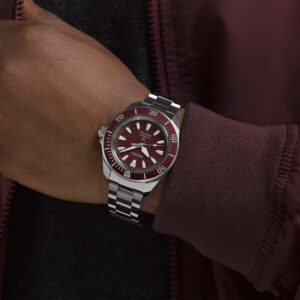Watch Movements
Want to know more about the types of watch mechanisms? Read on to learn about the various watch movements and how they work.
The movement, or caliber, is the engine that powers a watch and its functions. This internal mechanism of the timepiece moves the hands and powers all watch features such as the chronograph, annual calendar, moon phase or dual time zone. As the driving force of all timekeeping functions, a movement is the most vital component of any timepiece. There are a variety of types of watch movements that have been created by watch manufacturers throughout the years of horology. All movements, however, fall into one of two categories: quartz or mechanical. (There is no “best watch movement type” as each has its own advantages.)
An easy way to differentiate between quartz and mechanical movement watches is by observing the characteristics of the second hand’s motion across the dial. The second hand of a quartz watch has a ticking motion which moves one distinct tick per second, while the second hand of a mechanical watch has a smooth, sweeping motion.
Quartz Movement
When comparing watch mechanism types, quartz movements are more accurate than mechanical movements and require relatively little maintenance besides periodic battery replacements. The average lifetime of a battery ranges from 12 to 36 months. Quartz watches tend to have lower prices due to their less intricate internal mechanisms. Quartz movements in luxury Swiss watch brands, such as TAG Heuer or Breitling, are designed with strict quality control standards and are highly reliable. Although they are more accurate and less costly, battery-operated watches tend to be less desirable to most watch enthusiasts because they lack the internal craftsmanship and engineering of a mechanical movement.
Mechanical Movement
Mechanical movements are often preferred over quartz movements for luxury watches because of the elegance inherent in the intricate level of quality and craftsmanship of mechanical movements. Created by professional watchmakers in Switzerland, these movements contain intricate components that work together to power the timepieces which house them. Although the concept of mechanical watches has not changed much in decades, advances in technology yielded more precise engineering of mechanisms.
How a Mechanical Movement Works
Unlike quartz movements, a mechanical movement uses energy from a wound spring, rather than a battery, to power the watch. This spring stores energy and transfers it through a series of gears and springs, regulating the release of energy to power the watch. There are two types of mechanical movements found in luxury timepieces: manual and automatic, each with unique characteristics. Although mechanical movements are preferred to quartz, the type of mechanical movement is a matter of personal preference.
Manual Movement
Manual movements are the oldest and most traditional types of watch mechanisms. These movements are typically referred to as “hand-wound movements” because they must be wound manually to build energy in the mainspring of the timepiece.
How a Manual Movement Works
The user must rotate the crown multiple times in the winding position in order to wind the mainspring and fill the power reserve. Mainsprings unwind slowly and release energy through a series of gears and springs that regulate the movement. This is what powers the watch hands and complications.
Winding Intervals
Winding intervals for manual-wind watches depend on the power reserve capacity of each watch movement, which can be anywhere from 24 hours to several days. Some watches may require daily winding while others, like the Panerai Radiomir PAM00384 which sports an eight- day power reserve, only need to be wound approximately every eight days. The power reserve is filled by manually winding the crown 40-50 full revolutions (please refer to the user’s manual for detailed instructions). Each time the power reserve is drained, the timepiece will require a manual wind to initiate movement.
Automatic Movement
The second form of mechanical movement is automatic, referred to as a self-winding automatic movement. These mechanical movements provide energy to the mainspring derived from the motions of the user’s wrist. Automatic movements tend to be very popular because the wearer does not have to worry about constantly winding the watch to maintain operation. Once the power reserve is filled, the timepiece must be worn actively for 8 to 10 hours per day to sufficiently self-wind and remain powered.
How an Automatic Movement Works
Automatic movements function nearly the same way as manual movements, with the addition of an oscillating metal weight, or rotor. The rotor is attached to the movement and rotates freely. Wrist movement causes the rotor to spin which provides energy to wind the mainspring.
Winding Intervals
Automatic watches still require winding, but less often than manual timepieces. If a watch is worn every day, it should maintain timekeeping functions without requiring additional winding. If a watch has not been worn for an extended period or is constantly left idle overnight, it will need to be wound in order to fill the power reserve. A simple alternative to manually winding automatic watches is to use a watch winder, which will keep the watch wound when not in use.







 Need help?
Need help?
